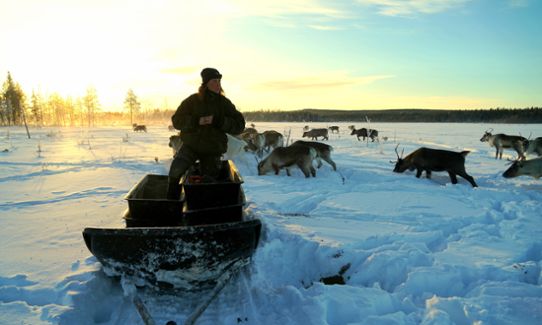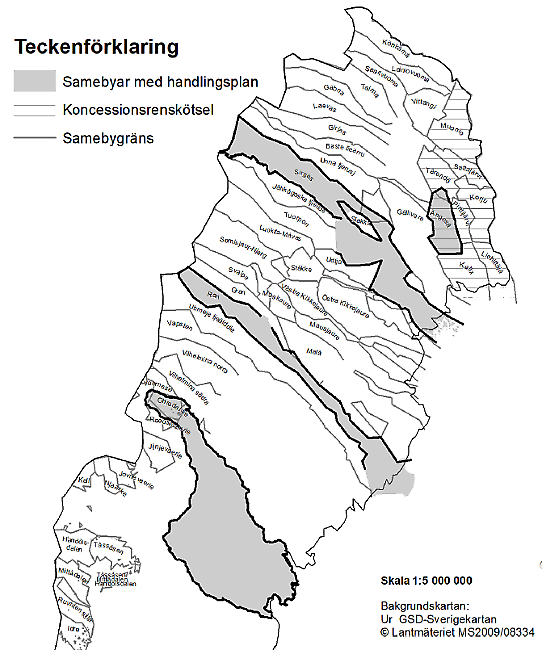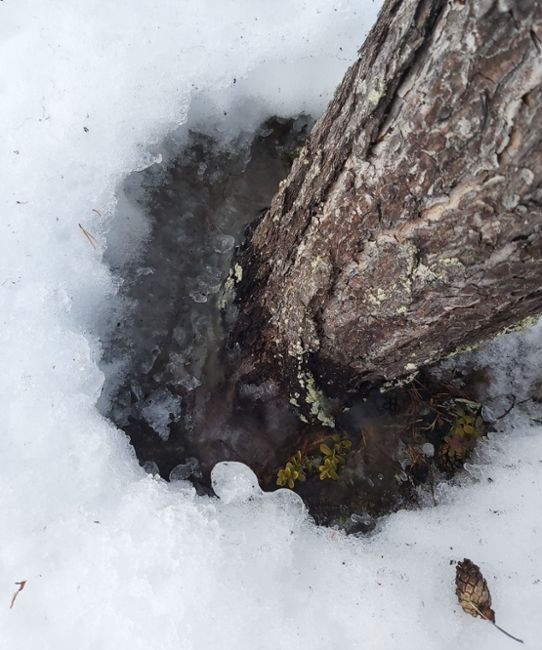In Sweden, the average temperature is rising, precipitation is expected to increase and extreme weather events to increase. The reindeer husbandry area extends over the northern half of Sweden, where warming is most pronounced. Already today, reindeer husbandry is impacted in several ways by the consequences of climate change.
Reindeer husbandry is reserved for members of “samebyar”, i.e. Sámi districts (or reindeer herding districts, used alternately below), and is based on free grazing of reindeer, as they are migratory animals. By law, all public sector activities in Sweden must promote the Sámi people's opportunities to maintain and develop their own cultural and community life. However, the Sámi Parliament of Sweden is the authority responsible for promoting Sámi culture. It initiates activities and proposes measures promoting Sámi culture. In order for society to adapt to a changing climate, authorities have an important role to play in initiating, supporting and evaluating climate change adaptation work within their respective areas of responsibility. As part of the Sámi Parliament's climate change adaptation work, an action plan for climate change adaptation has been developed. In the action plan, the Sámi Parliament of Sweden states that "the key to successful climate change adaptation is to reduce vulnerability through flexibility". For reindeer husbandry, this could translate into sufficient access to different types of grazing land, an action which often involves conflicts of interest with other land users.

In the Sámi Parliament's action plan for climate change adaptation, various areas for action were identified. One of the efforts to achieve the action area “increased flexibility” was that the Sámi districts themselves would carry out independent climate and vulnerability analyses and formulate action plans for climate change adaptation. In this way, an overall picture is created of the challenges that reindeer husbandry faces and also how resources for adaptation measures can be provided.
The County Administrative Board of Norrbotten, the Sámi Parliament and the county administrative boards in the reindeer husbandry area (Norrbotten, Västerbotten, Jämtland, Västernorrland and Dalarna) decided to initiate a pilot project. The project took place between the autumn of 2017 and the autumn of 2018, and involved the Sámi districts of Ohredahke, Ran, Sirges and Ängeså (see map, figure 2).

Pilot project to manage the climate impacts on reindeer husbandry
The purpose of the pilot project was for the Sámi districts to study and analyse how climate change can affect the conditions for reindeer husbandry, identify problems and analyse possible proposals for measures to take. The measures will be used as a baseline for the Sámi Parliament's continued work on climate change adaptation. Another purpose of the project was that, after the end of the project, the climate and vulnerability analyses and the action plans produced would be the starting point for the work on climate change adaptation in all Sámi districts. Through the action plans, the relevant decision-makers and authorities must also work preventively so that reindeer husbandry and the Sámi culture can respond to climate change in a better way.
The vulnerability of reindeer husbandry to a changing climate
In their climate and vulnerability analyses, the Sámi districts of Ängeså, Sirges, Ran and Ohredahke concluded that climate change affects reindeer husbandry in many ways. For example, warmer temperatures lead to precipitation falling as rain instead of snow in winter and to more days with zero crossings, which means temperature changes around zero degrees. This results in ice formation on the ground or snow, and to soil lichens becoming difficult to graze for reindeer – so-called locked grazing. This results in the need for reindeer herds to spread out in the search for grazing, thus making them exposed to a greater risk of predator attacks.
Due to the fragmentation of the landscape, many reindeer herding districts lack larger contiguous grazing land to spread the herds on when the pasture freezes. Competitive land use, such as industrial forestry, mining and hydropower, reduces the area of grazing land and makes it more difficult for the reindeer to move. Industrial plantation forestry also causes less access to forests with hanging lichens, which serve as spring and reserve grazing for the reindeer. With less access to hanging lichen grazing, locked grazing events require reindeer to receive supplementary feeding, which is costly and requires a great deal of work. Less access to hanging lichen also affects the reindeer's health, as supplementary feed cannot replace the reindeer's natural food. With climate change, locked grazing is expected to become more common and is considered one of the biggest threats to reindeer husbandry.
In many reindeer grazing areas, a lot of snow often falls at once during winter. Ice and ice crust formation from zero crossings in combination with deep snow means that the reindeer cannot move or dig for food. They also find it difficult to smell the lichen.

Zero crossings also mean that major roads are salted for better road safety. The reindeer seek out the salt and thus risk being hit by a moving vehicle, a problem already experienced by Ängeså Sámi district.
The extent of snow cover and the period with continuous snow cover is expected to become shorter in the future. The ice on lakes and other water bodies also becomes thinner in winter, which makes it difficult for reindeer herds to move. High flows in waterways due to heavy rainfall can make the movement of reindeer (on foot) impossible between pastures.
A warmer climate leads to a longer growing season, which means longer open field grazing but also a shift in reindeer husbandry work and a potential need for new migration routes and facilities. The reindeer's rut can come later due to the heat, causing the calves to be born later and hence, making them less resilient in the coming winter. A warmer and wetter climate also increases the risk of insects spreading to new areas, leading to exposure to new diseases for reindeer. A warmer climate also causes insects to become more active, impacting the reindeer grazing peace.
The length and frequency of heat waves are also expected to increase, which in combination with other factors, contribute to forest fires. In the event of a forest fire, winter grazing can be completely destroyed, something that was experienced during the hot Swedish summer of 2018. During the summer of 2018, an area in Ohredahke's reindeer herding district was hit by wildfire, which served as an eye opener to other potential climate change impacts than the challenge of locked grazing in the winter.
Suggested measures
In their respective action plans, the Sámi districts have come up with a number of proposals for measures to respond to the consequences of a changing climate. One proposal is to identify and make available alternative winter grazing land as in large parts of the land, lichens have disappeared in recent decades as a result of industrial forestry. Another proposed measure is to adapt roads to the needs of reindeer husbandry, involving actions such as setting up fences or finding alternatives to road salt. Additional proposals are the purchase of mobile reindeer husbandry facilities and mobile silos to be able to use the land more efficiently.
Since the pilot project ended, Ängeså Sámi district has applied for and been granted funding for the purchase of a mobile facility. Funds come from the Sámi Parliament's promotion grant in 2019, which was specifically aimed at adaptation measures. During the past years’ dry summers, pastures have been flushed to reduce dust that bothers the calves' eyes. Reindeer have also been kept in smaller winter groups to be able to use smaller areas of pasture and hanging lichens. Also, supplementary feed has been provided to reindeer roaming the forests when the reindeer lichen heaths are locked in by ice.
The work process
The Sámi Parliament announced the pilot project in the autumn of 2017. Conditions for participation in the pilot project involved the need for a designated working group with a responsible contact person and the approval that the results of the pilot is delivered to the Sámi Parliament, Sámi districts and other relevant actors. Participants in the project also needed to prove that they were able to register data in RenGIS, where “ren” means reindeer in Swedish. RenGIS is a geographical information system where Sámi districts, among other information, report their Reindeer Husbandry Plan. A reindeer husbandry plan is a description of land use within a Sámi district, which can be used in, for example, land use consultations.
A representative from the Sámi Parliament was selected as project manager and functioned as an initiator with support from the climate change adaptation coordinator at the County Administrative Board in Norrbotten. Climate data from the Swedish Meteorological and Hydrological Institute (SMHI) was used in the analysis and a representative from SMHI participated as expert support during the project. Researchers from the Swedish University of Agricultural Sciences (SLU) and Umeå University contributed with their knowledge about hanging lichen and ground lichen grazing. The county administrative boards in the reindeer husbandry area have contributed with funding and support.
Four Sámi districts carried out the pilot project and each presented a final report. The work began with a start-up meeting where, among other things, the climate change adaptation coordinator at the County Administrative Board of Norrbotten showed examples of implementation. Based on this, the Sámi districts had to decide for themselves which methods they wanted to use. The Sámi Parliament provided guidance during the project, including at individual meetings in the Sámi districts. Several of the meetings included representatives from the County Administrative Board and SMHI. After the end of the pilot project, a consultant compiled a synthesis report that summarised the pilot work.
In the development of the climate and vulnerability analysis, Sámi traditional knowledge has been used together with scientific knowledge. Some Sámi districts conducted interviews with members of the district about, for example, risks and proposals for initiatives. Six people were involved in Ängeså Sámi district's work process. Two reindeer herders and two retired reindeer herders were interviewed about their perspective of climate change and two people from the board wrote the report. The work was limited to studying snow cover, precipitation, temperature, growing season, zero crossings, heat waves and wind. The Sámi district chose to study climate change based on a scenario of higher emission levels (RCP8.5). The scenario was chosen with the justification that if the reindeer herding district is equipped for such large climatic changes, they are also equipped for smaller climatic changes. Other Sámi districts conducted their analyses on the basis of lower emission levels (RCP4.5) or applied both scenarios.
Challenges and experiences
A challenge regarding the measures proposed in the action plans is that the Sámi districts do not have a mandate to implement several of them but are dependent on other industries and political decisions. For certain measures, Sámi districts can apply for investment support from the Rural Development Program and from the Sámi Parliament. The Sámi districts are run as economic associations, which results in difficulties in finding other solutions to apply for funding of climate change adaptation measures.
To Ängeså Sámi district, the geography also affects their conditions for adaptation. The land surface is relatively small and round, which means that the climate is largely the same everywhere in the area. Mountain reindeer herding districts that are long and narrow, stretching east to west, often have a more varied climate. Having a uniform climate is a disadvantage because it reduces the flexibility of the pasture when the grazing is locked.
The climate data available for the Sámi districts is not adapted to the needs of reindeer husbandry. The Sámi Parliament has identified that in order to conduct better analyses, some data need to be divided into individual months instead of four fixed seasons, and data are needed for the number of days with snow depths over one meter. A dialogue around this issue has taken place during and after the pilot project with SMHI, which produces the data.
The project has generally received a positive response. The Sámi districts and the Sámi Parliament experienced the cooperation positively and the funds were considered reasonable in relation to the scope of the project. Through the project, Ängeså Sámi district identified consequences they had not thought of before and realized the importance of preparedness, such as mobile facilities that allow them to use land that lacks stationary facilities.
The Sámi districts thought that the support was sufficient but identified climate education as an area for improvement. Ängeså Sámi district emphasized the importance of learning about the climate in advance so that the conditions of the reindeer industry can be explained and analysed in a uniform way. During the work process, the biggest challenge for Ängeså Sámi district was to differentiate between climate and weather. With the results in hand, they had wanted to limit themselves to one or two clear issues specific to their reindeer herding district. Initially, however, their climatological knowledge was limited resulting in many different parameters being investigated. They believed that other Sámi districts can benefit from lessons learned from the scope and delimitations of their report
The Sámi Parliament also believed that the work could have been improved by investing more resources in improved synchronization of reindeer husbandry and local knowledge with climate information and data. This also applies to the integration of the work and knowledge held in the Sámi district when the project is over. Sámi traditional knowledge was also emphasized in relation to observations of climate change.
Financing
The county administrative boards contributed SEK 150,000 (approximately € 15,000) each, and thus a total of SEK 750,000. Four pilot Sámi districts received SEK 120,000 each for the implementation of the project, which was earmarked for working hours or consulting assistance. The Sámi Parliament contributed with its own working hours. The remaining funds went to the consultant's work with the synthesis report, training and to further projects concerned with the development of climate and vulnerability analyses and action plans. The County Administrative Board of Norrbotten and the Sámi Parliament also financed the reworking of GIS data.
Evaluation
A survey was conducted at the pilot Sámi districts to evaluate the project and draw lessons for future projects. The pilot project has been presented at a Reindeer Husbandry Planning Conference, which has inspired more reindeer herding districts and increased interest in climate change adaptation. The Sámi Parliament assessed that the climate change adaptability has increased among Sámi districts.
The pilot project established a baseline for continued work. The plan is for the county administrative boards in the reindeer husbandry area to finance the work of two Sámi districts per year during the period 2019–2023, where the various counties are represented. At the start of the project during the winter of 2019, two Sámi districts in Norrbotten carried out climate and vulnerability analyses and developed action plans. In 2020, three reindeer herding districts in Jämtland and Dalarna began their work.
More examples of climate adaptation
This is one of many examples of climate adaptation. There are more in the collection of ideas being built up by the Swedish National Knowledge Centre for Climate Change Adaptation at the Swedish Meteorological and Hydrological Institute (SMHI). The collection of examples has the aim of sharing experiences and providing ideas to everyone who works with climate adaptation. Examples describe concrete measures and challenges in several subject areas. They show how different actors have worked to adapt their activities to the climate changes that are already being noticed today and those that we cannot prevent in the future.